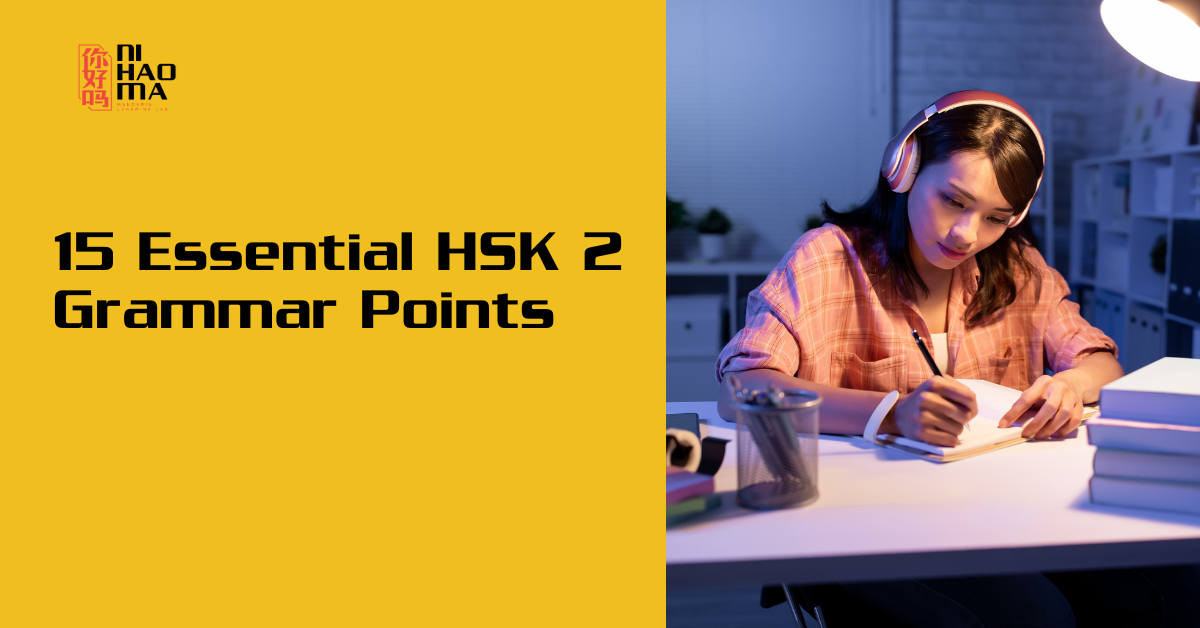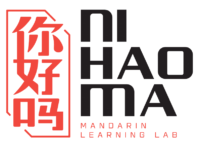I. Introduction
The HSK (Hanyu Shuiping Kaoshi) is a standardized Chinese proficiency test, with Level 2 (HSK 2) representing a basic understanding of Mandarin. At this level, learners can handle simple conversations, daily tasks, and express personal information.
However, mastering HSK 2 grammar is crucial for transitioning from beginner to intermediate levels. A solid grasp of these grammar rules not only helps in understanding more complex conversations but also enables learners to construct sentences that are essential for effective communication.
Understanding grammar at this stage will lay a strong foundation for HSK 3 and beyond, and the focus is on core sentence structures, word usage, and common patterns. Let’s explore the essential grammar points that will help you excel in HSK 2.

II. 15 Essential Grammar Points
1. 了 (le) for Completed Actions
The particle “了” is widely used in Mandarin to indicate that an action is complete. Its role is essential because Mandarin does not have verb tenses like English. Instead, “了” is added to show that something has been finished or has occurred.
A. Explanation of “了” for Action Completion
In most cases, “了” is placed after the verb to mark the completion of an action. Unlike in English, where verb conjugation signals tense, Mandarin relies on particles like “了” to communicate whether an action has been completed. This distinction is key for expressing past events or finished actions.
B. Examples:
- 我吃了晚饭。 (Wǒ chīle wǎnfàn.) – I have eaten dinner.
- 他走了。 (Tā zǒule.) – He has left.
C. Tips on Common Errors and Corrections One common mistake is misplacing “了” or using it when unnecessary. Remember that “了” does not indicate the past tense but rather the completion of an action. Avoid using “了” for habitual actions or states that are not finished.
2. 是 (shì) for Identity and Definition
“是” (shì) is the verb used to define or identify subjects. Unlike other verbs, it plays a role similar to “to be” in English.
A. Using “是” to Define or Identify “是” is often used in sentences to describe something’s identity or to define relationships between objects or people.
B. Examples:
- 这是我的家。 (Zhè shì wǒ de jiā.) – This is my home.
- 她是医生。 (Tā shì yīshēng.) – She is a doctor.
C. Differences from Other Verbs Like “有” (yǒu) The verb “有” (yǒu) means “to have” or “there is/are,” which is different from “是.” While “是” is used for identification, “有” is used for possession or existence. Compare:
- 她有一本书。 (Tā yǒu yī běn shū.) – She has a book.
3. Verb + 得 (de) + Adjective for Ability or Degree
In Mandarin, the structure “Verb + 得 (de) + Adjective” is used to describe the manner or degree to which an action is performed. It answers questions such as “how well” or “to what degree.”
A. Describing How Well an Action is Performed The particle “得” (de) connects the verb and adjective, describing the performance of the action.
B. Examples:
- 他说得很好。 (Tā shuō de hěn hǎo.) – He speaks very well.
- 我跑得很快。 (Wǒ pǎo de hěn kuài.) – I run very fast.
C. Practice Forming Sentences with Different Adjectives The structure allows flexibility with adjectives, enabling various descriptions. For example:
- 她唱得很美。 (Tā chàng de hěn měi.) – She sings beautifully.
4. Question Words with 也 (yě) and 都 (dōu)
“也” (yě) and “都” (dōu) are adverbs used for inclusiveness. “也” means “also,” and “都” means “all.” Both words are important for making comparisons or adding emphasis in questions.
A. Using “也” and “都” for Inclusiveness “也” is used when adding another subject to a statement, while “都” is used to include all members of a group.
B. Examples:
- 你也喜欢看书吗? (Nǐ yě xǐhuān kàn shū ma?) – Do you also like reading?
- 他们都去了。 (Tāmen dōu qùle.) – They all went.
C. Tips on Usage for Emphasis Incorporating “也” and “都” in questions allows you to add emphasis. Be cautious, as “也” should be placed before the verb, while “都” generally comes after the subject but before the verb.
5. Verb + 的 (de) + Noun for Descriptions
The structure “Verb + 的 + Noun” is used for creating descriptive phrases. This pattern is crucial for making sentences more specific by adding detail to nouns.
A. Describing Nouns with Verbs When you want to describe a noun using a verb, you place “的” after the verb.
B. Examples:
- 我喜欢吃的水果。 (Wǒ xǐhuān chī de shuǐguǒ.) – The fruit I like to eat.
- 她买的衣服。 (Tā mǎi de yīfú.) – The clothes she bought.
C. Practice Forming Descriptive Phrases Experiment with forming your own descriptive phrases by changing the verb or noun. For example:
- 他看的书。 (Tā kàn de shū.) – The book he read.
6. Adjective + 了 (le) for Change in State
In addition to marking completed actions, “了” is used with adjectives to indicate a change in state. This is a significant aspect of Mandarin grammar.
A. Indicating a Change in Adjective State When an adjective is followed by “了,” it shows that the condition has changed.
B. Examples:
- 天气变冷了。 (Tiānqì biàn lěng le.) – The weather has become cold.
- 她高兴了。 (Tā gāoxìng le.) – She became happy.
C. Avoiding Confusion with Other Uses of “了” While “了” marks completion with verbs, its role with adjectives is different. Be mindful of the context to avoid confusion.
7. Verb + 不 + Verb for Negative Capability
To express inability or the negation of an action, Mandarin uses a simple repetitive verb structure: “Verb + 不 + Verb.”
A. Expressing Inability or Negation This structure effectively communicates whether someone can or cannot do something.
B. Examples:
- 他听不懂。 (Tā tīng bù dǒng.) – He doesn’t understand.
- 我做不到。 (Wǒ zuò bù dào.) – I can’t do it.
C. Usage in Negative Sentences Ensure the negative form “不” is correctly placed between the repeated verbs to maintain clarity.
8. Verb + 一下 (yíxià) for Softening Requests
In Mandarin, “一下” (yíxià) is often added after verbs to soften a request or make it more polite.
A. Using “一下” for Softer Requests or Suggestions This structure can transform a command into a polite suggestion.
B. Examples:
- 请等一下。 (Qǐng děng yíxià.) – Please wait a moment.
- 看一下这个。 (Kàn yíxià zhège.) – Take a look at this.
C. Differences Between “一下” and Similar Phrases “一下” softens the tone, making it less direct than simply using the verb alone.
9. Conjunctions: 和 (hé) and 但是 (dànshì)
Connecting words and ideas is a fundamental part of constructing sentences. Two essential conjunctions are “和” (hé) for “and” and “但是” (dànshì) for “but.”
A. Connecting Ideas with “和” and “但是” “和” is used to link similar ideas, while “但是” connects contrasting ideas.
B. Examples:
- 我喜欢苹果和香蕉。 (Wǒ xǐhuān píngguǒ hé xiāngjiāo.) – I like apples and bananas.
- 我很累,但是我还要工作。 (Wǒ hěn lèi, dànshì wǒ hái yào gōngzuò.) – I’m tired, but I still need to work.
C. Placement and Usage in Complex Sentences It’s important to remember that “和” cannot connect entire sentences like “and” in English. It’s only used for connecting nouns or noun phrases.
10. Place + 有 (yǒu) + Noun for Location
The structure “Place + 有 (yǒu) + Noun” is crucial for indicating that something exists or is located in a particular place. It allows you to point out objects or people within a specific location.
A. Indicating Presence of Something at a Location This structure is used to express that there is something in a place or that something exists somewhere.
B. Examples:
- 教室里有一张桌子。 (Jiàoshì lǐ yǒu yī zhāng zhuōzi.) – There is a desk in the classroom.
- 公园里有很多人。 (Gōngyuán lǐ yǒu hěn duō rén.) – There are many people in the park.
C. How to Use “有” Effectively “有” is placed between the location and the object, making it a very straightforward way to describe what is present in a given place. It’s essential to avoid placing time expressions after “有” because it refers specifically to existence or presence, not time-related events.
11. Verb + 过 (guò) for Past Experiences
The particle “过” is used to indicate that someone has experienced or done something in the past. This is different from “了,” which marks completed actions but doesn’t necessarily imply past experiences.
A. Talking About Past Experiences with “过” “过” is often used to talk about something that has been done at least once in the past. It highlights that the action was performed at some point in time.
B. Examples:
- 我去过中国。 (Wǒ qùguò Zhōngguó.) – I have been to China.
- 她看过那个电影。 (Tā kànguò nàgè diànyǐng.) – She has seen that movie.
C. Differentiating “过” from Other Past Tense Markers While both “过” and “了” can be used to talk about the past, “过” is specifically for experience, while “了” denotes completion. Be careful not to mix the two. For example, “过” cannot be used to talk about something that just happened unless it’s referring to experience.
12. Adverb + 也/都 for Emphasis
Mandarin uses adverbs like “也” and “都” to emphasize inclusiveness or shared experiences among subjects. This can strengthen your sentence and make it more specific.
A. Using “也” and “都” with Adverbs “也” is used to indicate “also,” while “都” refers to “all.” When combined with adverbs, these particles add emphasis to the sentence, making it more specific.
B. Examples:
- 我今天也去。 (Wǒ jīntiān yě qù.) – I am also going today.
- 他们都很高兴。 (Tāmen dōu hěn gāoxìng.) – They are all very happy.
C. Practice Exercises for Different Adverbs Practice using “也” and “都” with various adverbs. For example, use time adverbs (like 今天 jīntiān – today) to show that an action is happening at the same time for multiple subjects:
- 他们都昨天去了。 (Tāmen dōu zuótiān qùle.) – They all went yesterday.
13. Verb + 给 (gěi) for Giving or Doing for Others
The preposition “给” (gěi) means “to give” or “for” and is used to indicate that something is being done for the benefit of another person. It’s essential in expressing acts of giving or doing something on behalf of someone else.
A. Expressing Giving or Doing Something for Someone “给” is used in sentences where an action is being performed for someone else’s benefit or to give an object to someone.
B. Examples:
- 他给我一本书。 (Tā gěi wǒ yī běn shū.) – He gave me a book.
- 我给你做饭。 (Wǒ gěi nǐ zuòfàn.) – I cook for you.
C. Proper Sentence Structures and Common Errors When using “给,” it’s important to place the person receiving the action immediately after “给.” A common mistake is to reverse the order, which can confuse the meaning.
14. Time Expressions + Verb for Timing
In Mandarin, it’s common to place time expressions at the beginning of a sentence, before the verb, to indicate when something will take place. These time words help clarify the temporal aspect of an action.
A. Indicating When an Action Takes Place Time expressions are used to mark when an event occurs, giving the listener a clear understanding of the time frame.
B. Examples:
- 昨天我去了商店。 (Zuótiān wǒ qùle shāngdiàn.) – I went to the store yesterday.
- 明天我们见面。 (Míngtiān wǒmen jiànmiàn.) – We will meet tomorrow.
C. Combining Time Words Effectively Time expressions usually appear at the beginning of a sentence, unlike in English, where they often come at the end. Practice forming sentences that combine different time expressions:
- 每年我去旅游。 (Měi nián wǒ qù lǚyóu.) – I go on a trip every year.
15. Verb + 了 + Duration for Duration of Actions
The structure “Verb + 了 + Duration” is used to describe how long an action has been happening or occurred. This helps learners express the duration of ongoing actions in the past or present.
A. Describing the Duration of an Action with “了” When expressing how long something has been taking place, you use the particle “了” followed by the time duration to indicate the length of time an action has been or was happening.
B. Examples:
- 我学了三年中文。 (Wǒ xuéle sān nián zhōngwén.) – I have studied Chinese for three years.
- 她等了半小时。 (Tā děngle bàn xiǎoshí.) – She waited for half an hour.
C. Common Mistakes and Practice Sentences One common mistake is omitting “了” after the verb, which causes confusion about whether the action is ongoing or completed. Practice forming sentences with various time durations to get comfortable with this structure.
III. Conclusion
Mastering these HSK 2 grammar points is a vital step toward improving your Mandarin proficiency. Each of these structures builds on the basics and introduces more nuanced ways to express yourself. By focusing on these key grammar rules, learners will become more confident in both speaking and writing Mandarin.
Consistent practice is the key to success in learning Mandarin. The more you familiarize yourself with these structures, the more natural they will feel in conversations. Don’t be afraid to experiment with sentence construction and challenge yourself with different combinations of these grammar points.
Are you ready to take your Mandarin skills to the next level? Explore the Ni Hao Ma HSK Online course for live practice with native teachers and a structured learning path to help you master HSK 2 grammar and beyond. Whether you’re just starting or looking to refine your skills, our courses provide comprehensive support to help you achieve fluency. Contact Us Now!



